 Leading Blog | Posts by Month |
 Leading Blog | Posts by Month |
05.31.21

LeadershipNow 140: May 2021 Compilation
See more on
Posted by Michael McKinney at 09:02 AM
05.28.21

Always End with the Beginning in Mind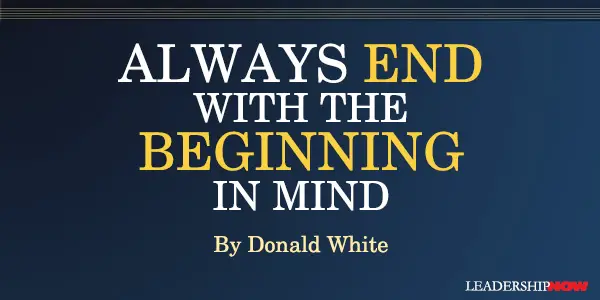
AS the Baby Boomers continue to age, business continuity and succession planning are on everyone’s radar. Take, for example, the financial industry: the average age of financial advisors in the U.S. exceeds age 50, and less than 12 percent of advisors are under the age of 35. In my observation, among the most successful advisors, the median age is even higher. The number of financial advisors who die or are limited by medical issues while still practicing is reaching an epidemic. An estimated 40 percent of today’s advisors will exit by the end of the 2020s, whether the advisors like it or not. Consequentially, this has piqued the industry’s interest for many years. Shoemakers, Fix Your Own Shoes! Advisors pride themselves on asking clients the hard questions about business continuity and succession. Consequently, it’s routine to ask clients:
For most business people, their single largest asset is their business, and what becomes of their largest asset is a huge deal. They’re asking themselves:
Everyone knows that there’s only one thing certain in life: everybody dies. Making provision for death, disability, and retirement is simply not optional. Unless I guess you’re a financial advisor! While advisors love to discuss business continuity with their customers, as a group, they do a horrible job of advising themselves. It’s a classic case of “shoemaker fix your own shoes” where a personal succession plan is apparently on tomorrow’s to-do list. Recently I had a discussion with an older colleague. I asked him what would become of his firm if he died, became disabled, or decided to retire? While not completely ignoring the first two possibilities, he pounced on the idea of retirement, saying, “Retire? I’m having too much fun to retire! Besides, most people who retire are either dead or disabled a year later anyway.” Sadly, my friend represents a significant percentage of advisors today who think they’ll somehow cheat fate and work forever. My first mentor told me, “Always do what’s in the best interest of the person sitting in front of you, and your interest will always take care of itself.” While I find most great businesspeople believe in this adage as it applies to the way they treat their customers, it doesn’t necessarily carry over to the way they treat their own businesses. Could intentionally building a business to have it continue into perpetuity be in the best interest of the clients, the employees, the successor, and the founder? What if, in executing a succession plan, everyone wins? The Cream Rises Until It Sours Back in the 1960s, Laurence Peter, a Canadian sociologist, wrote The Peter Principle. What Dr. Peter’s research found was that just because an employee stands out in one position doesn’t mean he or she will excel at another. In fact, employers frequently elevate people with what Peter famously called a promotion to their “level of incompetence” and suffer the inevitable consequences associated with the decision. They often simply don’t possess the skills needed to succeed in their new position. It’s not so much a case of the person being incompetent, but rather they are not suited for the role. One of Peter’s famous statements was, rather than cream rising to the top, “cream rises until it sours.” This can lead to organizations becoming almost entirely filled with people inadequate for the tasks they’re assigned to fulfill. Too many good advisors aren’t particularly good businesspeople. Their advisory skills don’t necessarily translate into an ability to lead and build organizations with the proper infrastructure to continue beyond themselves. Every advisor needs to examine whether he or she is the soured cream keeping the firm from being able to thrive for the long-term. The Goldilocks Dilemma Most of us are familiar with the tale of Goldilocks and the Three Bears. When Goldilocks eats from three bowls of porridge, one is too hot, one is too cold, one is just right. The problem is that no one can know for certain when an exit is just right. Indeed, when it comes to exiting a business, you can either leave too soon or you can leave too late. “Just right” is simply not an option. Because too soon and too late are the only real options, the question is, how do you choose between two imperfect alternatives? The answer is to leave too soon because leaving too late is disastrous. However, leaving too soon is the difficult choice because, at least on the surface, you wonder if you’d have been better off waiting. That is the Goldilocks Dilemma — you can never know if the timing is just right. My advice is to end with the beginning in mind. Allow your firm to become even greater after you depart by putting the right people and systems in place that will allow the firm to be even greater with each successive generation of leadership. I exited my company in 2019 and have watched how, even amid a pandemic, everyone has prospered. Indeed, my successors grew the firm by nearly 25 percent in 2020. Our clients and employees love my successors and have shown how much they appreciate the transition. Meanwhile, my life has never been better as I write and teach. Be Fearless! Succession planning can be challenging for numerous reasons, but the biggest challenges are usually internal, not external. James Clear, in his book, Atomic Habits, describes three levels of behavior change. The first level is outcomes. The second is changing your process. However, the deepest level is changing your identity or what you believe about yourself. Most succession plans focus on outcomes or selling the business without considering identity — or who they see themselves as internally. This leads many to a fear the succession process and becomes the root cause of moving the subject to tomorrow’s to-do list. The best advisors find their identity in their businesses. The thought of not being an advisor is anathema to them. As a result, their greatest fear is deciding who they are if they’re not an advisor. A friend of mine sold his business to his hand-picked successor. While the business outcome was great, internally, he was a mess. Without his agency, he lost his identity. This past year he started another agency because, in truth, he couldn’t re-identify as anything other than an agent. While no one can say what the best business succession solution is for any organization, be open to the myriad of possibilities there are in succession planning. Take it off tomorrow’s to-do list. Create a succession plan that looks out for everyone’s best interest — in which everyone wins. Indeed, if it’s not a win-win, call the whole thing off. Remember, you can exit too early or too late, but waiting until the time is just right is fool’s gold. Most of all, be fearless.  
Posted by Michael McKinney at 03:40 PM
05.27.21

Leading Thoughts for May 27, 2021
IDEAS shared have the power to expand perspectives, change thinking, and move lives. Here are two ideas for the curious mind to engage with: Teresa Amabile on how to kill creativity: “Organizations routinely kill creativity with fake deadlines or impossibly tight ones. The former create distrust and the latter cause burnout. In either case, people feel overcontrolled and unfulfilled—which invariably damages motivation. Moreover, creativity often takes time. It can be slow going to explore new concepts, put together unique solutions, and wander through the maze. Managers who do not allow time for exploration or do not schedule in incubation periods are unwittingly standing in the way of the creative process.” Source: Harvard Business Review: How to Kill Creativity Authors John Hagel, John Seely Brown, and Lang Davison say we often don’t even know what we are looking for or the questions to ask to get there, so it calls for a different approach: “We need serendipitous encounters with people because of the importance of the ideas that these people carry with them and the connections they have. People carry tacit knowledge. … You’ve got to stand next to someone who already knows and learn by doing. Tacit knowledge exists only in people’s heads. As edges arise ever more quickly, all of us must not only find the people who carry the new knowledge but get to know them well enough (and provide them with sufficient reciprocal value) that they’re comfortable trying to share it with us.” Source: The Power of Pull: How Small Moves, Smartly Made, Can Set Big Things in Motion Look for these ideas every Thursday on the Leading Blog. Find more ideas on the LeadingThoughts index.
Posted by Michael McKinney at 07:19 AM
05.24.21

5 Leadership Lessons: The Bomber Mafia
THE IDEA of conducting an air war was born from the traumatic and tragic lessons learned from World War 1. The goal was to help make the deadly, wasteful, pointless conflict on the ground obsolete with precision bombing. The precision part was the problem until Carl Norden came along and invented a bombsight for more accuracy. It would begin to change how we fought wars. Strategic bombing from high altitude, in daylight, with precision bombing to make war less lethal. The Bomber Mafia: A Dream, A Temptation, and The Longest Night of the Second World War by Malcolm Gladwell is a story about “the messiness of our intentions.” The Bomber Mafia was born from new technology—airpower. It was their belief that “We don’t have to slaughter the innocent, burn them beyond recognition, in pursuit of our military goals. We can do better.” Their belief did not die but was put on hold in the early morning hours of March 10, 1945, on what became the longest night of World War 2. On that night, 279 B-29’s dropped incendiary bombs on Tokyo, Japan. Gladwell asks, “How is it that, sometimes, for any number of unexpected and random reasons, technology slips away from its intended path?” The Bomber Mafia held to their belief. “They persisted, even in the face of technology’s inevitable misdirection, even when abandoning their dream offered a quicker path to victory, even when Satan offered them all the world if only they would renounce their faith. Without persistence, principles are meaningless. Because one day your dream may come true. And if you cannot keep that dream alive in the interim, then who are you?”

Posted by Michael McKinney at 09:25 AM
05.21.21

101 Things I Learned in Business School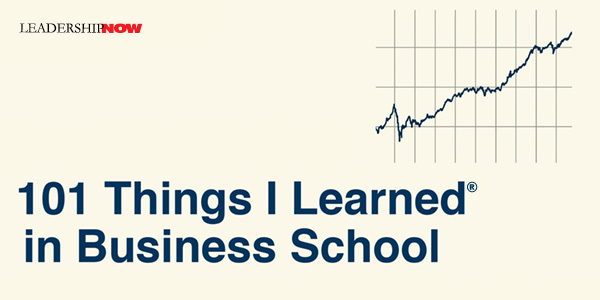
BUSINESS is not a discipline, but an endeavor made up of disciplines such as accounting, communications, economics, finance, leadership, management, marketing, operations, psychology, sociology, and strategy. 101 Things I Learned in Business School, written by Harvard MBA, Dr. Michael Preis helps to provide the broad knowledge based needed to succeed in business. Each lesson is concise and illustrated by Matthew Frederick. It is valuable for those just beginning o study business and a tool to explore more into areas where you could profit from learning more about. Some of the lessons (with excerpt) include: Lesson: Those who think theory “isn’t the real world” don’t understand what theory is. Those who are adverse to theory may thrive in business as long as the parameters familiar to them remain in place. Those who embrace theory are more likely to seek out, adapt to, and benefit from new situations. Lesson: Write it Once A well-written contract defines or explains each term or condition only once. Repeating contract language in an effort to impart greater emphasis is dangerous, as differences in context can lead to confusion in meaning and an unfavorable interpretation in a court of law. Further, because negotiations invariably require editing of contract language, a redundantly worded contract will require changes in multiple locations—leading to the possibility that one location will be missed and an inconsistent document will result. Lesson: A profitable company may be chronically short of cash. A business typically makes a sale before payment is received from the customer, while the costs related to that sale, such as materials, labor, commissions, and overhead are borne up front. Consequently, a business may be short of cash until payment is received. An especially fast-growing company with rapidly increasing sales can be chronically short of cash, because the costs of growth (hiring and training new employees, acquiring new facilities and equipment, financing an ever-growing inventory, etc.) perpetually exceed the cash receipts from the previous, smaller sales volume. Procuring and maintaining adequate capital is crucial especially for new businesses. Undercapitalization is one of the most common causes of business failure. Lesson: Learn an organization’s culture before working with or for it. A poor culture match can not only create discomfort for workers, but can compromise endeavors at a corporate scale—undermining mergers, partnerships, and working relationships that are a good match by non-cultural measures.
Lesson: Moral Hazard A moral hazard exists when organizations and individuals are not required to bear the negative consequences of their failures. Moral hazards can result from a positive feedback loop: for example, a lender insured by the government against loan default may make very risky, high-interest loans to uncreditworthy customers because it will do no worse than break even, and may realize a very high rate of return. Lesson: The higher one rises in an organization, the more one must be a generalist. At the lower level of an organization, employees usually have direct knowledge of specific activities. … Managers often lack such specific knowledge and skills but have generalized understandings of personnel, training, motivation techniques, evaluation, product distribution, compensation, and budgeting. …At the highest executive levels, officers and board members may be concerned with the philosophical direction of the company, the organization’s mission, and the meanings of the company’s brand in the market. Lesson: If all options appear to be equal, get more information. When feeling stuck while weighing an important decision, it is almost always helpful to seek out new, objective information on any aspect of the matter—even if the effort tor information to be gained initially seems of little value. Even the most modest new data on a market, client, or technology, when probed seriously, can provoke expansive new insights that point toward a more informed decision. Lesson: An expert isn’t always the person who knows the most. Experts know a lot, but often it is better to know how to organize, structure, and contextualize, knowledge than to simply have knowledge. Innovative thinkers don’t merely retain and retrieve lots of information; often they identify and create new patterns and connections that reorient or reframe what others know. Lesson: The point of a visual presentation is to get the audience to listen. It can be tempting to pack slide or presentation boards with extra information to look smart or give the audience extra value. But he most effective visual presentations are clear, concise, and even terse. … If you have additional details to convey, put them in a takeaway handout or send them afterward in a thank-you email.

Posted by Michael McKinney at 03:12 PM
05.20.21

Leading Thoughts for May 20, 2021
IDEAS shared have the power to expand perspectives, change thinking, and move lives. Here are two ideas for the curious mind to engage with: Robert Heinlein on dying cultures: “Sick cultures show a complex of symptoms such as you have named…but a dying culture invariably exhibits personal rudeness. Bad manners. Lack of consideration for others in minor matters. A loss of politeness, of gentle manners, is more significant than is a riot.” Source: Friday (1982) Ben Horowitz on what you get is based on who you are: “Trying to screen for ‘good people’ or screen out ‘bad people’ doesn’t necessarily get you a high-integrity culture. A person may come in with high integrity but have to compromise it to succeed in your environment. People become the culture they live in and do what the have to do to survive and thrive.” Source: What You Do Is Who You Are: How to Create Your Business Culture Look for these ideas every Thursday on the Leading Blog. Find more ideas on the LeadingThoughts index.
Posted by Michael McKinney at 08:34 AM
05.18.21

Badvertising: Lessons from the Creative World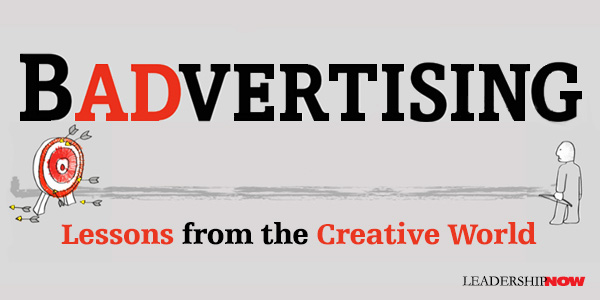
DIRECTED at the folks in advertising, Badvertising: An Exposé of Insipid, Insufferable, Ineffective Advertising contains lessons for all of us. Credited with some of the best advertising copy ever produced, Jim Morris has taken his experience in advertising and exposed in a series of essays the Agents of Stupidity that derail the process of creating, targeting, and evaluating advertising. These same Agents of Stupidity hold leaders in all contexts back in a time when the clear thinking that leads to creativity and innovation is much needed. Some of the lessons include: The sad reality, however, is that pandering to clients’ wants rather than identifying and meeting clients’ needs is one of the most pervasive Agents of Stupidity in our industry. 
Posted by Michael McKinney at 02:15 PM
05.13.21

Leading Thoughts for May 13, 2021
IDEAS shared have the power to expand perspectives, change thinking, and move lives. Here are two ideas for the curious mind to engage with: Joann Lublin on how parenting can make parents better leaders and bosses: “A high proportion of younger mothers and fathers believe that parenthood makes them better leaders, another study revealed. About 55% of parents under 35 “strongly agree” that’s true—compared with 28% of ones over 45, a 2019 survey of 1,003 individuals with and without children stated. Source: Power Moms: How Executive Mothers Navigate Work and Life Malcolm Gladwell on the birth of revolutions: “Revolutions are invariably group activities. Rarely does someone start a revolution alone. Revolutions are birthed in conversation, argument, validation, proximity, and the look in your listener’s eye that tells you you’re on to something.” Source: The Bomber Mafia: A Dream, a Temptation, and the Longest Night of the Second World War Look for these ideas every Thursday on the Leading Blog. Find more ideas on the LeadingThoughts index.
Posted by Michael McKinney at 08:38 AM
05.12.21

Scenario Planning vs. Forecasting: 6 Questions to Ask to Prepare for a Post-Pandemic Future
AS WE finally start to see the light at the end of the tunnel of the catastrophic COVID-19 pandemic, many business leaders are looking for ways to better anticipate future disruptions and prepare for uncertainty ahead. There is often confusion between scenario planning and forecasting, with the terms used interchangeably and inconsistently. But these are different methods that involve specific activities, outcomes and value add. Scenario planning is focused on the future and involves defining different stories behind different paths that will lead to that future. You could also say it is based on a dynamic sequence of interacting events, causal processes, and critical decision points. It offers enhanced flexibility and preparedness to deal with risk and uncertainty instead of purely quantitative forecasting. It is about understanding multiple plausible futures without blinkers on, identifying what could happen, and describing that outcome in a compelling, engaging narrative. Scenarios are also collaborative—typically involving teams of people, often from various levels within an organization—and there is often a creative dimension, as opposed to being purely based on quantitative number-crunching. Scenarios provide longer-term, multiple futures based on unknown risks and uncertainties (e.g., the results of a U.S. election). Forecasts, on the other hand, are constructed on the assumption that the world in the future looks much like it does today. Forecasting is a less creative process and does not anticipate significant shifts in the business environment, which can cause considerable challenges for organizational strategy and a firm’s performance. Also, forecasts do not factor in risks and uncertainty as part of a broader stakeholder dialogue or research exercise. Instead, forecasting uses quantitative inputs and methodology to help predict what will, or should, happen in the future, mainly by interpreting historical data. Forecasting is a shorter-term tool that provides certainty based on known variables in the system (e.g., passenger traffic for airlines). To put it more bluntly: Forecasts offer one possible future, whereas scenarios offer multiple possible futures. Neither tool is better than the other; they simply offer different approaches to solving problems and should be used in a complementary way. The table below provides a more detailed contrast between scenario planning and forecasting, comparing various features and explaining the differences:
When deciding which tool to apply to a problem or opportunity, there are six typical questions that you can ask to help identify whether scenario planning or forecasting will be more effective:
As Paul Saffo, a technology forecaster based in Silicon Valley, said, “the goal of forecasting is not to predict the future, but to tell you what you need to know to take meaningful action in the present.” In a world of so many different management tools at the fingertips of leaders, it’s vital to ensure you select the right one to drive the outcomes you need to be successful.  
Posted by Michael McKinney at 11:11 AM
05.06.21

Leading Thoughts for May 6, 2021
IDEAS shared have the power to expand perspectives, change thinking, and move lives. Here are two ideas for the curious mind to engage with: Susan McPherson on making a genuine connection with others: “We’re living in a loneliness epidemic that is causing declines in physical and mental health, as well as decreased work satisfaction and performance. It’s clear that the art of connecting is lost. We’re talking, Zooming, Tweeting, and texting, but we’re not feeling a sense of connection. People have lost their sense of belonging and purpose in their careers and their lives. Why? Because we’ve come to lean too hard on our digital lives. Virtual connections are not the end; they are the means to an end—an authentic relationship with depth, be it professional or personal.” To uncover your what drives you, Victoria Labalme offers the Desert Island Question: “If you were on a deserted island dying and you knew you weren’t going to make it … that this was the end… but there was a young person with you—someone you cared about deeply … and if—before you died—you could give that young person only one piece of advice about life and how they might best live theirs … what would that one piece of advice be?” Source: Risk Forward: Embrace the Unknow and Unlock Your Hidden Genius Look for these ideas every Thursday on the Leading Blog. Find more ideas on the LeadingThoughts index.
Posted by Michael McKinney at 06:14 AM
05.03.21

Never Say Never: The Importance of Word Choice in Leadership Communication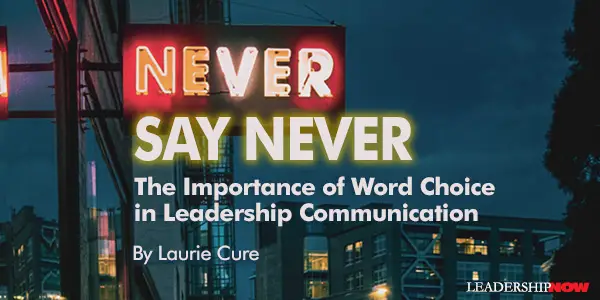
LANGUAGE matters. As I conduct observation coaching with leaders, I watch for how their words resonate with their audience. Does what they say induce fear? Excitement? Do attendees in the meeting cringe at certain words, or do their metaphors generate inspiration? Effective leaders use communication as a critical competency to build trusting relationships, align team members around a vision, lead necessary change, and drive action. Communication involves verbal, non-verbal, and intuitive delivery and receiving of messages. It also requires listening and speaking with intention. In support of that, the communication process typically involves five critical steps.
Any missteps, gaps, or errors in these stages can lead to a serious breakdown in the communication cycle. It can destroy relationships, damage trust, and contribute to adverse impacts on business outcomes. In medicine, law enforcement, education, and almost every profession, communication failures lead to lasting negative impacts. The best leaders maneuver these five steps in a way that leaves their teams feeling heard, understood, and valued. To accomplish this, leaders have a responsibility to ensure they are appropriately using every step of the communication cycle to deliver an accurate message. Effective communication is difficult for a variety of reasons. Our lack of knowledge around cultural differences, as well as human factors such as stress, fatigue, and communication skills, all play a role in the potential breakdown of communication. Today, there is an emphasis on rapid decision making, and fast-paced problem solving that often involve many parties and differing perspectives. Given these variables, there are several things to keep in mind to avoid communication breakdown. 1. Avoid Certain Words There are words that create a negative emotional reaction regardless of the intent behind the word. We certainly do not need to eliminate all these words, but carefully considering your purpose, tone, and the desired reaction can ensure these words do not leave others frustrated or disengaged.
2. Be Cautious When Using Idioms I have made this mistake too many times to count. Recently, I met with a partner from France. I used the idiom, “let me put a bug in your ear,” to share an idea I wanted her to consider. That phrase was unfamiliar to her, and my intention was lost on her. While idioms seem helpful to make a point, there is also a significant risk that they originated and have a history that is different than your intention in today's world. Ethic, cultural, racial, or religious idioms that were accepted and used in the past may no longer be appropriate today. 3. Avoid Absolutes “Nobody does it better,” or “I have the best employee/team.” Again, while this is often used to elevate those close to us, it generally has the effect of alienating others and diminishing their skills and abilities. Additionally, terms like all, none, must, never, only, always can be hooks. They have no exceptions and do not leave room for error or discussion. They can be taken as condensing and make others feel inferior. The words we use matter, especially in a leadership role where our teams regularly react and listen closely to what we share. Start paying attention to the reactions you receive when speaking and cut out the words and phrases that are spurring a negative response. 
Posted by Michael McKinney at 09:25 AM
05.01.21

First Look: Leadership Books for May 2021Here's a look at some of the best leadership books to be released in May 2021. Don't miss out on other great new and future releases not listed here.
Have you ever dreaded Sunday night, got a pit in your stomach on the way to work, or had your heartbeat speed up at the sound of your boss’s voice? If so, you may have had anxiety at work. In this empathetic and wise guide, executive coaches and gurus of gratitude Adrian Gostick and Chester Elton explore the causes of workplace stress and anxiety and the management practices that have proven successful in reducing tension and cultivating calm. In today’s volatile, fast-paced, and ever-changing global climate, organizations and their employees are under more pressure than ever to perform. Anxiety at Work shows how everyone at all levels can work together to build an environment that fosters camaraderie, productivity, and calm.
What if the next global crisis is a mental health pandemic? It is here now. One-third of Americans have shown signs of clinical anxiety or depression, and the current state of suffering globally has risen significantly. The mental health pandemic manifests everywhere, not least in your workplace. As organizations around the world face health and social crises, as well as economic uncertainty, acknowledging and improving wellbeing in your workplace is more critical than ever. Increasingly, leaders and managers must support mental health and cultivate resilience in employees — not just increase engagement and performance. Based on more than 100 million Gallup global interviews, Wellbeing at Work shows you how to do just that.
Almost ten years ago, Bloomberg journalist Brad Stone captured the rise of Amazon in his bestseller The Everything Store. Since then, Amazon has expanded exponentially, inventing novel products like Alexa and disrupting countless industries, while its workforce has quintupled in size and its valuation has soared to well over a trillion dollars. Jeff Bezos’s empire, once housed in a garage, now spans the globe. Between services like Whole Foods, Prime Video, and Amazon’s cloud computing unit, AWS, plus Bezos’s ownership of The Washington Post, it’s impossible to go a day without encountering its impact. We live in a world run, supplied, and controlled by Amazon and its iconoclast founder. Definitive, timely, and revelatory, Stone has provided an unvarnished portrait of a man and company that we couldn’t imagine modern life without.
The definitive guide to communicating and connecting in a hybrid world. Humans rely on body language to connect and build trust, but with most of our communication happening from behind a screen, traditional body language signals are no longer visible -- or are they? In Digital Body Language, Erica Dhawan, a go-to thought leader on collaboration and a passionate communication junkie, combines cutting edge research with engaging storytelling to decode the new signals and cues that have replaced traditional body language across genders, generations, and culture. In real life, we lean in, uncross our arms, smile, nod and make eye contact to show we listen and care. Online, reading carefully is the new listening. Writing clearly is the new empathy. And a phone or video call is worth a thousand emails. Digital Body Language will turn your daily misunderstandings into a set of collectively understood laws that foster connection, no matter the distance. Dhawan investigates a wide array of exchanges―from large conferences and video meetings to daily emails, texts, IMs, and conference calls―and offers insights and solutions to build trust and clarity to anyone in our ever changing world.
An all-in-one resource for every working mother and father. Sure, there are plenty of parenting books out there. But as working moms and dads, we've never had a trusted, go-to guide all our own—one that coaches us on how to do well at work, be the loving and engaged parents we want to be, and remain true to ourselves in the process. Enter Workparent. Whether you're planning a family, pushing for promotion during your kids' teenage years, or at any phase in between, Workparent provides all the advice and assurance you'll need to combine children and career in your own, authentic way. Written by Daisy Dowling, a top executive coach, talent expert, and working mom, Workparent answers all of your questions and feels like a good talk with your favorite mentor.
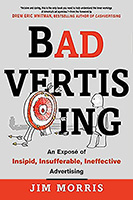  
 Build your leadership library with these specials on over 28 titles. All titles are at least 40% off the list price and are available only in limited quantities. “The great thing is to be always reading but never get bored—treat it not like work, more as a vice.” — C. S. Lewis
Posted by Michael McKinney at 07:12 AM
|
BUILD YOUR KNOWLEDGE


How to Do Your Start-Up Right STRAIGHT TALK FOR START-UPS 
Grow Your Leadership Skills NEW AND UPCOMING LEADERSHIP BOOKS 
Leadership Minute BITE-SIZE CONCEPTS YOU CAN CHEW ON 
Classic Leadership Books BOOKS TO READ BEFORE YOU LEAD |
|